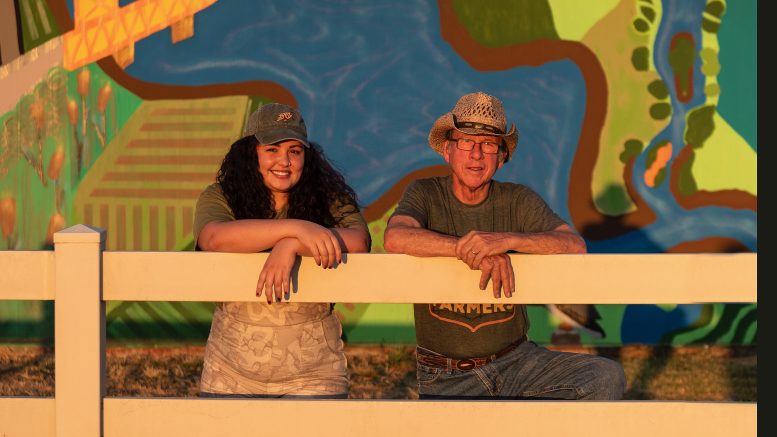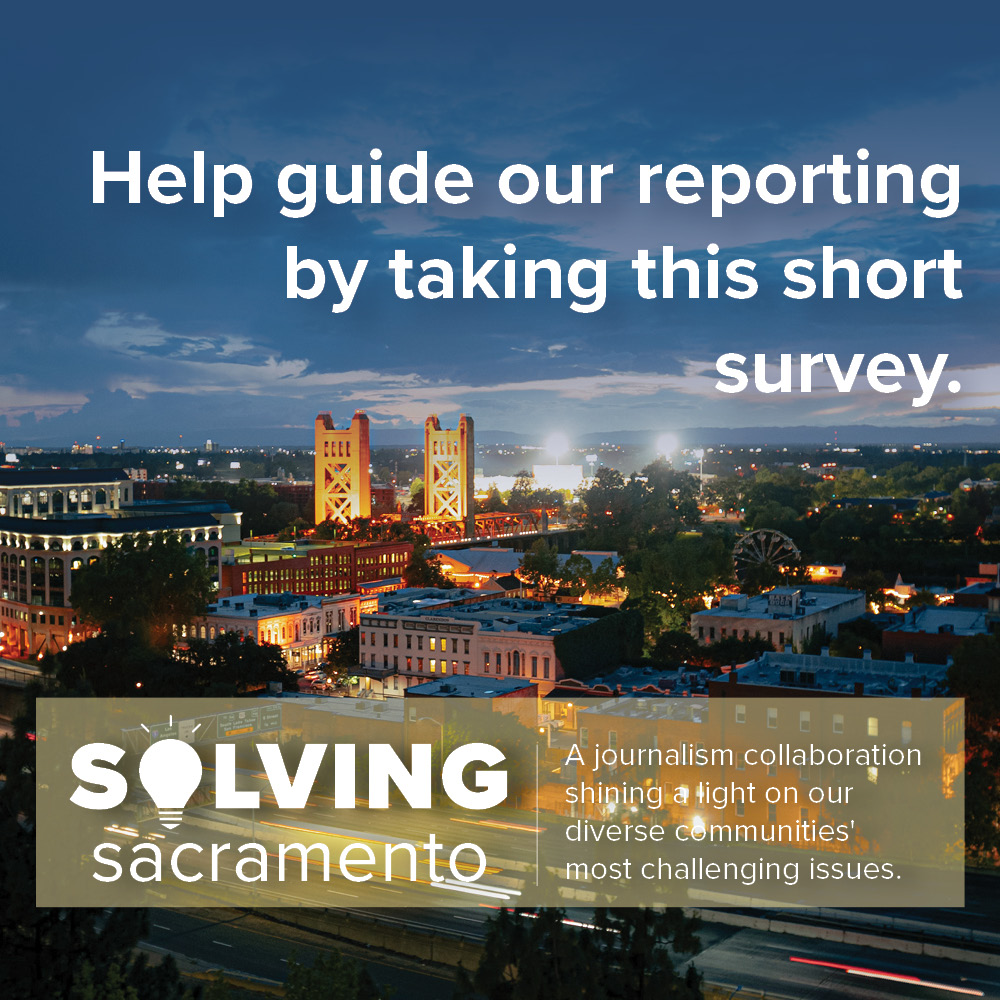Trail of murals illustrates sustainable agricultural practices to raise awareness on climate change
Laurie Lauletta-Boshart
Driving north through rural Davis, Jullianne Ballou noticed a series of signs on Pole Line Road with compelling messages. The missives all had a climate awareness theme, with catchy phrases: “Orchards capture carbon,” and “What a climate bargain.” Another proclaimed “Race to net zero.”
“I thought the signs were incredibly effective because I wondered where I could learn more,” she says. Ballou, who later accepted a position as associate director of strategic initiatives for the UC Davis Institute of the Environment, was renting a farmhouse on the land that featured the signs, a 9,000-tree almond orchard owned by Mike Russell, a former UC Davis professor and part-time farmer.
The timing was fortuitous for Russell, who had been trying to get the university engaged in student climate projects for a while. “With Jullianne on the property, that made things much more workable because we could talk easily,” he says.
The idea of using public art to pictorially display the impact of climate change began with Russell and neighbor Steve Shaffer, both veterans of the Yolo County agricultural community. The pair used the 1950s Burma-Shave signs as inspiration for their own.
“In the 1950s, Burma-Shave placed signs along well-traveled highways about driving and speed, often injected with a bit of humor,” says Russell. “We saw art as an influential way to communicate the urgency of the climate crisis.”
They also created an education website titled AgClimateHeroes.org to inform the public, noting that farms produce 11% of the global greenhouse emissions that contribute to climate change, but also can be part of the solution when implementing sustainable practices like soil management, renewable energy and carbon sequestration. Russell and Shaffer next set their sights on larger artwork and a bigger canvas, namely the side of Russell’s barn.
Visualizing a climate-friendly place
Russell and Shaffer partnered with the Institute and EmilySchlickman, a UC Davis landscape architecture and environmental design professor, to get the project off the ground. Schlickman designed and taught a one-unit course in fall 2021 on art and climate change activism, culminating in a mural competition. She brought in guest artists from across the country who engaged with climate change in their work.
“For the first half of the quarter, I wanted the students to understand the various approaches for using art to instigate change,” Schlickman says. For example, a downtown Los Angeles mural was painted with a special cool paint that served to bring down the ambient temperature, addressing the issue of urban heat. In the second half of the quarter, Schlickman and the students surveyed the mural site and each developed their own proposals for Russell’s barn. The winning design was submitted by UC Davis engineering grad student Rachael Dal Porto, who used her proposal to project into the future with climate-resilient crops, restored wetlands, e-buses and cooling centers.
“Her illustration was almost like a porthole into what Sacramento could look and feel like if we were to implement climate-friendly practices,” says Schlickman.
Sacramento muralist Leon Willis led the Dal Porto mural, opting to use a paint-by-numbers approach. A community paint day was planned and spearheaded by Schlickman and the Institute, and organized by Heather Lieb, a graduate student in the Agricultural and Environmental Chemistry department. More than 250 people — ranging in age from three to 80 — participated in the community-based event, which featured live music, food and educational booths.
Even Schlickman’s 4-year-old daughter grabbed a paintbrush and added her own flair. “I had some expectations for what it was going to be like and it totally blew me away,” says Schlickman of the paint day. “People were excited about the art, but it also sparked conversation about what we can do.”
After the success of the first mural, the decision was made to expand the project to additional sites. “We have noticed more and more of these murals and types of art installations popping up,” says Ballou. We would like to be able to link these different projects and art initiatives so the climate art trail can be large and diverse.”
Schlickman agrees. “It should be bigger than just one barn.” The mural project has been dubbed the California Climate Art Trail. Additional murals are currently planned in downtown Davis and Sacramento.
More murals on the way
Rachel Hartsough, the arts and culture manager for the City of Davis is collaborating with Ballou on the Davis mural. “We are really supportive of the project,” she says. “It falls in line with the goals of our program, both the arts program and the city’s larger sustainability and resiliency goals.”
Local muralist Gregory Shilling has been tapped to paint the Davis mural in spring 2024. The design is still a work in progress, but Shilling is looking for local examples where efforts are being made to improve the footprint of agriculture. He cites the Yolo County Bypass as a good example of how agriculture and the environment can work together to be productive for humanity and nature.
“It’s a really incredible ecosystem in the same place as really productive farmland,” Shilling says. “All of these different ecosystems connect in the bypass.”
Representing humans’ relationship with the land is another important element, as is depicting waterways that can coexist with nature and be efficiently captured and stored for more abundant water in drought-vulnerable regions. Shilling is also hoping to engage with high school art students.
“High school was a pivotal time for me; I was really on the fence on whether to pursue art as a career,” he says. “I would like to give these students the opportunity to see the process and see someone who is making a career out of art.”
The Sacramento mural is being led by Lieb, the UC Davis grad student and artist who helped with the first mural. Lieb has been studying air quality in the Imperial Valley, but was seeking a community-engaged opportunity in grad school.
“I believe as an environmental scientist, that a large part of the problem with the dissemination of science is that it often stays within the scientific community. It doesn’t actually get into the public where change can happen,” Lieb says.
Armed with funding from SMUD, the Institute and Lieb are partnering with Southside Community Garden to paint a mural on its garden shed. The mural is slated to be painted this fall. The design will focus on urban agriculture and how growing food within local communities can help mitigate the impact large-scale agriculture has on the climate, along with the benefit that insects provide to agriculture.
Lieb plans to use a paint-by-numbers style, like the first mural. UC Davis undergraduate students Adiella Kessler, an agriculture major, and Laila Penny, an art history student, are assisting on the project. For the community engagement component, Lieb is working with Western Service Workers Association to educate the public on the United Nations sustainable development goals, and is hoping to work with other local community-based organizations to inform the community about the importance of urban farming.
“Initially we were thinking these would all be murals in agricultural landscapes and dealing with farmers and farms,” says Schlickman. “But now we are realizing that there are so many different things we can do to mitigate and adapt to a changing climate, so we are looking at expanding the trail to cities and small towns to reach a really wide and diverse group of people.”
This story is part of the Solving Sacramento journalism collaborative. Solving Sacramento is supported by funding from the James Irvine Foundation and Solutions Journalism Network. Our partners include California Groundbreakers, Capital Public Radio, Outword, Russian America Media, Sacramento Business Journal, Sacramento News & Review, Sacramento Observer and Univision 19.



Be the first to comment on "Collaborative art raises climate consciousness in Davis"